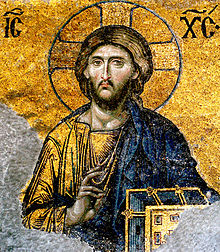

In Christian iconography, Christ Pantocrator (‹See Tfd›Greek: Χριστὸς Παντοκράτωρ, lit. 'Christ the Almighty')[1] is a specific depiction of Christ. Pantocrator or Pantokrator, literally ruler of all, but usually translated as "Almighty" or "all-powerful", is derived from one of many names of God in Judaism.
The Pantokrator is largely an Eastern Orthodox or Eastern Catholic theological conception and is less common under that name in Latin Catholicism. In the West, the equivalent image in art is known as Christ in Majesty, which developed a rather different iconography. Christ Pantocrator has come to suggest Christ as a benevolent, though also stern and all-powerful, judge of humanity.
When the Hebrew Bible was translated into Greek as the Septuagint, Pantokrator was used both for YHWH Sabaoth (צבאות) "Lord of Hosts"[2] and for El Shaddai "God Almighty".[3] In the New Testament, Pantokrator is used once by Paul (2 Cor 6:18) and nine times in the Book of Revelation: 1:8, 4:8, 11:17, 15:3, 16:7, 16:14, 19:6, 19:15, and 21:22. The references to God the Father and God the Son in Revelation are at times interchangeable, but Pantokrator appears to be reserved for the Father except, perhaps, in 1:8.
- ^ παντοκράτωρ. Liddell, Henry George; Scott, Robert; A Greek–English Lexicon at the Perseus Project
- ^ 2 Kings (2 Samuel) 7:8 and Amos 3:13
- ^ Job 5:17, 15:25 and 22:25